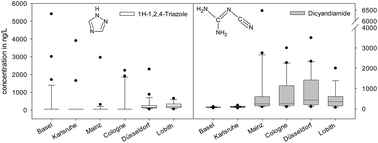Occurrence and fate of nitrification and urease inhibitors in the aquatic environment†
Abstract
Nitrification and urease inhibitors (NUIs) decelerate the bacterial oxidation of nitrogen species by suppressing the activity of soil microorganisms. Thus, nitrogen losses can be limited and the efficiency of nitrogen fertilizers can be increased. After application NUI transfers to surface water may occur through leaching or surface run-off. In order to assess the occurrence of nitrification and urease inhibitors in the aquatic environment a multi-analyte high-performance liquid chromatography-mass spectrometry method was developed. 1H-1,2,4-Triazole and dicyandiamide (DCD) were detected for the first time in German surface waters. Only at a few sites 1H-1,2,4-triazole has been episodically detected with concentrations up to the μg L−1-range. DCD was ubiquitously present in German surface waters. An industrial site was identified as the point source of DCD being responsible for exceptionally high DCD concentrations of up to 7.2 mg L−1 in close proximity to the point of discharge. Both compounds were also detected in at least one wastewater treatment plant effluent, but their concentrations in surface waters did not correlate with those of typical markers for domestic wastewater. Other NUIs were not detected in any of the samples. Laboratory-scale batch tests proved that 1H-1,2,4-triazole and DCD are not readily biodegradable, are not prone to hydrolysis and do not tend to adsorb onto soil particles. Ozonation and activated carbon filtration proved to be ineffective for their removal.

- This article is part of the themed collection: Emerging Investigators 2016

 Please wait while we load your content...
Please wait while we load your content...